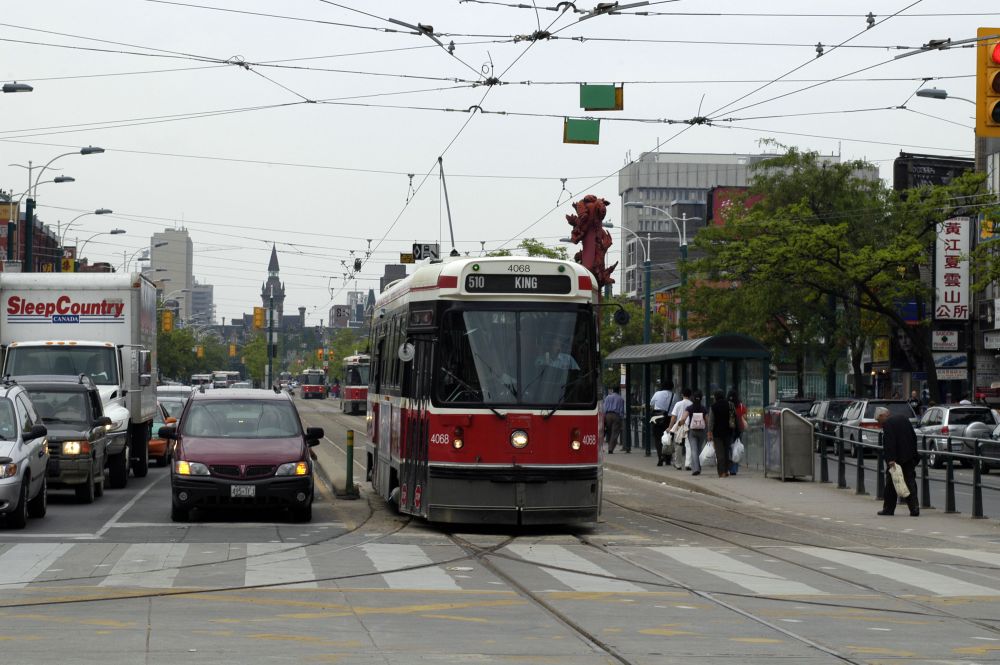
Kenyon F. Karl on 11/20/23
- Builder
- Hawker-Siddeley Canada
- Description
- Canadian Light Rail Vehicle
- Secondary Use
- none
- Type
- City and Suburban Streetcars
- Year
- 1980
- Retired from Service
- 2019
- Acquired by the Museum
- 2000
- Note
- No. 4068 is on display on a special section of wide gauge track.
- Fund
- 865A
Toronto Transit Commission 4068
From Toronto, Ontario
History
Toronto is the only North American city to have retained a significant part of its historic city-wide, traditional streetcar network. By the 1960s, when most U.S. and Canadian cities had abandoned their streetcar systems, Toronto Transit Commission (TTC) became the largest remaining streetcar operator in North America. The Toronto system uses an unusual 4’ 10 7/8” track gauge. In the 1970s, a large fleet of PCC streetcars served the city and which were approaching the end of their economic life. In 1973, the province of Ontario formed the Urban Transportation Development Corporation (UTDC) to develop new streetcars for TTC and for possible sale to other transit operators. After a worldwide evaluation of light rail technology, UTDC designed the state-of-the-art Canadian Light Rail Vehicle (CLRV). The CLRV was a sophisticated car with an on-board computer, spin-slide control and energy-saving chopper control. The TTC agreed to acquire a fleet of 200 (later reduced to 196) CLRVs. UTDC contracted with Swiss Industrial Company to build six test vehicles (Nos. 4000 – 4005) which were tested in Austria and Switzerland before delivery to Toronto in 1977-78. Hawker Siddeley Canada built the remaining 190 CLRVs (Nos. 4010 – 4199) at its former Canadian Car & Foundry plant in Thunder Bay, Ontario. Hawker Siddeley delivered the cars between 1979 and 1981. The UTDC failed to find other buyers for its CLRVs.
The TTC used the CLRVs on all its lines. The cars came with a new, bright red, black and white paint scheme. Passengers appreciated the smooth ride, bright fluorescent lighting and large windows, although the cars were not air conditioned (except for No. 4041). In the late 1980s, 52 Articulated Light Rail Vehicles (ALRVs) were added to the fleet, eventually resulting in the end of PCC car operation. The ALRVs shared much of the CLRVs industrial design. After a long service life, TTC began replacing the CLRVs with 204 accessible, low floor, articulated “Flexity” cars from Bombardier in 2014. By the end of 2019, TTC had received enough new cars to retire the last of the CLRVs.
In early 2020, the TTC donated No. 4068 to Seashore. The TTC also donated several other CLRVs to other museums. At Seashore, the CLRV joins Toronto “Peter Witt” streetcar No. 2890, built in 1923. The Toronto cars are part of the museum’s extensive collection of Canadian transit vehicles – the largest outside of Canada. The CLRV became the newest rail vehicle in the Seashore collection. Seashore initially moved No. 4068 to the Halton County Radial Railway (Ontario Electric Railway Historical Association) in Milton, Ontario for storage pending possible re-gauging work. Seashore brought the CLRV to Kennebunkport in December 2023 still with its wide-gauge trucks. The car is on display on a special section of wide-gauge track. The museum plans to convert No. 4068 to standard gauge in the future.
Technical Information
- Seats: 46
- Control: Garrett Chopper
- Brakes: Air Disk
Trucks
- Number: 2
Weight and Dimensions
- Length: 50’ 8.00"
- Width: 8’ 6.00"
- Height: 11’ 1.00"
- Weight: 51000 lbs.
Additional Images

Jim Shantz on 06/04/07
© 1998 - 2026 New England Electric Railway Historical Society. All Rights Reserved.